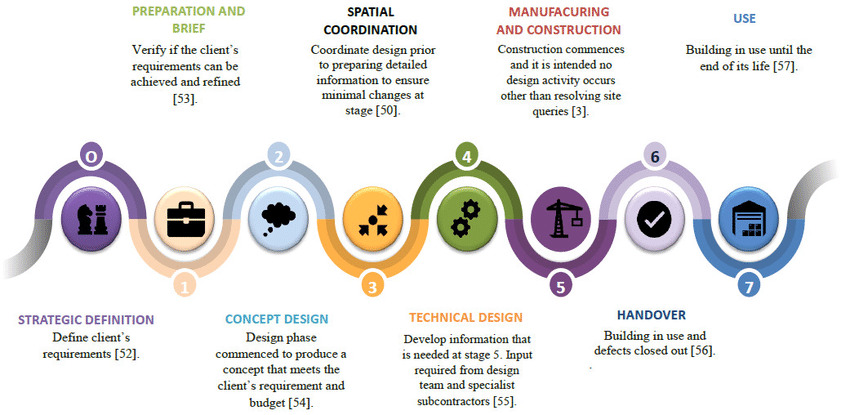The Ultimate Guide to Understanding RIBA Design Stages in Architecture

Are you familiar with the RIBA design stages in architecture? Whether you’re an aspiring architect or a curious homeowner looking to understand the process behind your dream home, this ultimate guide has you covered. In this comprehensive article, we will break down every RIBA—Royal Institute of British Architects design process stage, giving you a clear understanding of what to expect at each step.
Each RIBA stage is crucial in bringing a building project to life, from the initial conception and feasibility studies to the construction and handover. We’ll delve into each stage’s purpose, key activities, and deliverables, providing valuable insights for professionals and enthusiasts.
This guide focuses on clarity and accuracy and demystifies the intricacies of the RIBA design stages, empowering you to navigate the world of architecture confidently. So, whether you’re embarking on a new architectural project or simply seeking to expand your knowledge, join us to unravel the secrets behind the RIBA’s design process.
RIBA Design Stage: Strategic Definition
The first stage of the RIBA design process is the Strategic Definition stage. This stage sets the foundation for the entire project and involves establishing the client’s objectives, project brief, and budget. Defining the project’s purpose, identifying stakeholders, and understanding the site context is crucial.
During this stage, the architect collaborates closely with the client to develop a thorough understanding of their vision and requirements. Feasibility studies assess the project’s viability, considering site constraints, regulations, and environmental impact.
The key activities during the Strategic Definition stage include conducting site visits, gathering relevant information, conducting stakeholder interviews, and developing a project brief. The deliverables at this stage typically include a project brief document, a feasibility study report, and initial design concepts.
The Strategic Definition stage lays the groundwork for the project and ensures all parties are aligned regarding objectives and expectations. It sets the stage for the subsequent design stages and provides a solid foundation for decision-making throughout the project lifecycle.
Why RIBA and How It’s Helpful for Home Makers
You might be wondering why the RIBA design stages are essential, especially if you’re a homeowner looking to build or renovate your property. Understanding the RIBA process can greatly benefit homeowners as it provides a structured approach to project management, ensuring that all aspects of the design and construction are carefully considered.
RIBA design stages provide a framework for effective communication between the client, architect, and other project professionals. They allow for a clear understanding of project milestones, deliverables, and timelines, reducing the likelihood of misunderstandings or delays.
For homeowners, engaging an architect who follows the RIBA design stages can provide peace of mind, knowing that their project will be managed systematically and professionally. It ensures that the design is developed logically, considering all relevant factors such as site conditions, regulations, budget, and the client’s needs.
Following the RIBA design stages allows homeowners to better control the project’s progress and budget. Each stage allows for review and feedback, ensuring that any necessary adjustments can be made early on and minimising the risk of costly changes later in the process.
In summary, the RIBA design stages offer homeowners a structured and transparent process for their building projects, providing clarity and confidence throughout the journey. It enables effective collaboration between the homeowner and architect, resulting in a well-executed design that meets the client’s needs and aspirations.

RIBA Design Stage Benefits
The RIBA design stages offer numerous benefits for homeowners, architects, and other building industry professionals. Let’s examine some of these advantages.
- Clear Project Phases: The RIBA design stages provide a clear structure and sequence for project development. Each stage has defined objectives and deliverables, ensuring progress can be measured and monitored effectively.
- Better Decision Making: The RIBA process divides the project into stages, allowing for informed decision-making at each step. This ensures that important considerations, such as design options, cost implications, and regulatory requirements, are thoroughly evaluated before proceeding.
- Improved Collaboration: The RIBA design stages promote collaboration and communication among project stakeholders. Regular reviews and feedback sessions allow for a shared understanding of the project’s goals and enable effective problem-solving.
- Risk Management: Following the RIBA process helps mitigate risks by identifying potential issues early. Conducting thorough feasibility studies and considering various design options can address potential challenges proactively, reducing the likelihood of costly surprises during construction.
- Quality Assurance: The RIBA design stages incorporate quality control measures at each stage, ensuring the project meets the desired standards. Regular reviews and evaluations help maintain design integrity, construction standards, and regulation compliance.
- Efficient Resource Management: The RIBA design stages help optimise resource allocation by following a systematic approach. This includes financial resources, time, materials, and human resources. Efficient resource management leads to cost savings and timely project delivery.
While the RIBA design stages offer numerous benefits, it’s important to note that each project is unique, and flexibility is required to adapt the process to specific circumstances. The RIBA process provides a framework that can be tailored to suit the needs of individual projects, ensuring a successful outcome.
RIBA Plan of Works: Pros and Cons
The RIBA Plan of Work is a widely recognised framework that outlines the design and construction process of building projects. Let’s explore some pros and cons of using the RIBA Plan of Work.
Pros:
- Clarity and Structure: The RIBA Plan of Work provides a clear structure and sequence for project development. It identifies critical activities and deliverables at each stage, offering a logical design and construction process progression.
- Industry Standard: The RIBA Plan of Work is widely adopted, making it easier for architects, contractors, and other professionals to collaborate and communicate effectively. It provides a common language and reference point for all parties involved in the project.
- Flexibility: While the RIBA Plan of Work provides a standardised framework, it allows flexibility in adapting to specific project requirements. This ensures that the process can be tailored to suit the needs of individual projects, accommodating variations in scale, complexity, and procurement methods.
- Risk Management: The RIBA Plan of Work incorporates risk management measures at each stage, allowing potential issues to be identified and addressed early on. This helps minimise risks and ensures that projects can be delivered on time and within budget.
Cons:
- Complexity: The RIBA Plan of Work can be complex, especially for individuals unfamiliar with the terminology and processes involved in the construction industry. Navigating the framework effectively requires a certain level of understanding and expertise.
- Time-consuming: Following the RIBA Plan of Work requires thorough documentation and review at each stage. This can be time-consuming, especially for smaller projects or those with limited resources. It’s crucial to balance following the process and maintaining project efficiency.
- Rigid Structure: While the RIBA Plan of Work allows for flexibility, some argue that its approach can be too rigid. Projects with unique requirements or unconventional design processes may need help to fit within the framework’s predefined stages.
In conclusion, the RIBA Plan of Work offers clarity, collaboration, and numerous benefits for risk management. However, it’s important to consider each project’s specific needs and adapt the framework accordingly. The RIBA Plan of Work serves as a valuable guide, but ultimately, it should be tailored to suit the unique requirements of each building project.
Conclusion
Understanding the RIBA design stages is essential for anyone involved in architecture, from aspiring architects to homeowners embarking on building projects. The comprehensive framework provided by the RIBA process ensures clarity, effective communication, and efficient project management.
Each RIBA design stage, from the initial Strategic Definition stage to the final Handover stage, is crucial in bringing a building project to life. By following a systematic approach and considering critical factors at each stage, architects and homeowners can achieve successful outcomes that meet their objectives and aspirations.
The RIBA Plan of Work serves as a valuable guide, offering a standardised framework for project development. While it provides clarity and structure, adapting the process to suit each project’s unique requirements is essential.
In conclusion, the ultimate goal of the RIBA design stages is to create inspiring and functional spaces that enhance our built environment. By understanding and embracing the RIBA process, we can ensure that every architectural project is executed with precision, creativity, and attention to detail. So, whether you’re an architect, homeowner, or simply a curious observer, take the time to familiarise yourself with the RIBA design stages and unlock the secrets behind successful architectural projects.



